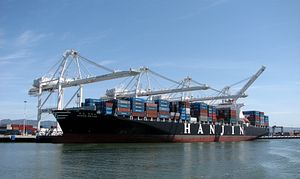Last Wednesday, Hanjin Shipping Co., the world’s seventh largest container shipper, filed for bankruptcy protection in Seoul’s central district court. The filing came a day after lenders, led by state-run Korea Development Bank, rejected the company’s restructuring proposal. Hanjin Shipping, which commands 2.9 percent of the global market share, had the equivalent of $5.3 billion of total liabilities on June 30, and had been posting losses in four of the last five years.
This potential bankruptcy, which would mark the largest failure of a container shipper in history, stranded 45 ships at sea, as the company is concerned that creditors would seize the cargo if the ships docked (as has happened in Singapore and some ports in China). Hanjin must file for bankruptcy protection in foreign courts as well to prevent further seizures.
Another problem is that ports and handlers around the globe – everywhere from South Korea to China, the United States, Canada, Spain, and elsewhere – are refusing to handle Hanjin’s cargo due to uncertainty about payment. Berthing and unloading services resumed at Pusan and Incheon on Friday, only after the government promised payment for the service providers.
Hanjin’s filing has led to its expulsion from the CKYHE Alliance, and alliance members have been forced to adjust fleet schedules to overcome delays caused by this disruption in their capacity-sharing arrangements. About 540,000 containers could be delayed anywhere from a few days to more than a month.
But, for rivals, this is a golden opportunity – a chance to raise the rates on trans-Pacific shipping. The timing, right before U.S. companies begin stocking up for the holiday season with cheap Asian finished goods, could not have been better.
As Hanjin represents nearly 8 percent of trans-Pacific trade volume for the U.S. market, this has prompted the National Retail Federation to appeal to the Department of Commerce and the Federal Maritime Commission to work with the South Korean government, ports, and others to prevent disruption to the supply chain. The U.S. Retail Industry Leaders Association also chimed in: “While the situation is still developing, the prospect of harm is significant and apparent … The impact on importers and exporters is having a ripple effect throughout the global supply chain.”
While Hanjin’s filing was not the only factor (China’s upcoming Golden Week holiday is also contributing), the shipping price from China to the U.S. west coast rose from $1,100 per container to as much as $1,700, and the price from China to the U.S. east coast from $1,700 to $2,400 last week.
While Hanjin’s troubles are unique to itself, its collapse is also symptomatic of a global shipping industry that is in dire straits. According to Drewry Maritime Research, the global shipping industry is set to lose about $5 billion this year. Freight shipping has suffered from overcapacity and falling trade volumes, which depressed freight rates. As The Guardian explains, “A weakened economy since the 2008 recession hurt global demand and trade at the same time that steamship lines continued to build more and larger vessels – immense ships that were conceived as cost-effective when freight costs were higher several years ago.” The merger of two of China’s largest carriers did not help either.
On Tuesday, South Korean officials said the government might provide the carrier with about $90.60 million of cheap loans if Hanjin’s parent company provided collateral. This will not be enough to save Hanjin, but will most likely be used to help Hanjin pay the fees to unload stranded cargo. Hanjin Shipping’s parent company is raising $90 million to fund the unloading of cargo.
While ships that have already docked are likely to be unloaded in the near future, the fate of ships and cargo still at sea appear far less certain.






























